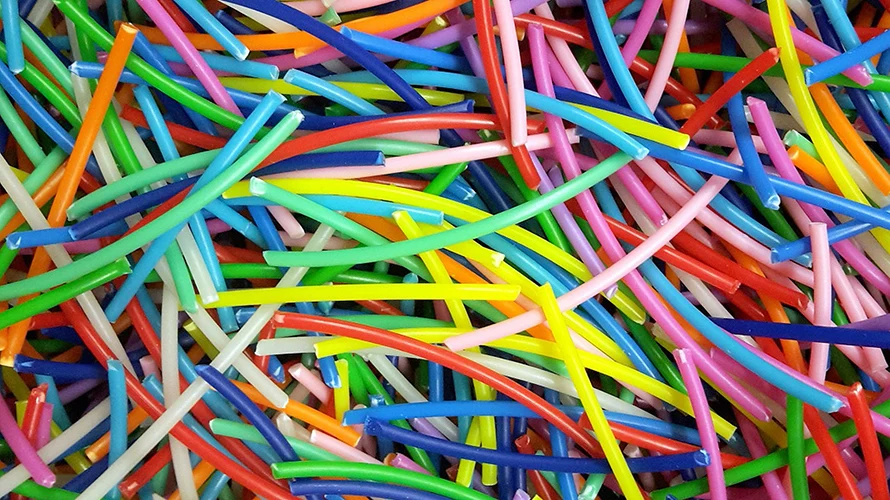A quick overview of the topics covered in this article.
Subscribe to the UKPACK newsletter to receive regular updates on the company, products, services, upcoming exhibitions and more.
As people become increasingly conscious of their environmental impact, interest in sustainable materials like polylactic acid (PLA) plastic has risen. PLA is a versatile and biodegradable alternative to traditional petroleum-based plastics, making it an attractive option for a variety of applications.
In this article, we will explore what PLA plastic is, its advantages and disadvantages, its applications, and its environmental impact.
What is PLA plastic
Polylactic acid, also known as PLA, is derived from any type of fermentable sugar. The majority of PLA plastic is produced from corn due to its affordability and widespread availability worldwide. Nonetheless, alternative options such as sugarcane, tapioca root, cassava, and sugar beet pulp can also be used to produce PLA.
It is a thermoplastic material that is widely used in the production of various products such as food packaging, cosmetic packaging, disposable cutlery, and 3D printing.
How is PLA Plastic Made
PLA plastic is made from renewable resources, such as corn starch, sugarcane, or potato starch. These materials are fermented to produce lactic acid, which is then polymerized to produce PLA plastic. The manufacturing process for PLA plastic is more sustainable compared to traditional plastics as it uses renewable resources instead of fossil fuels.
Advantages of PLA Plastic
There are several advantages of using PLA plastic over traditional plastics. These advantages include:
- Biodegradability and Compostability: PLA plastic is biodegradable and compostable, which means that it breaks down naturally over time, leaving no harmful residue in the environment. This makes it a more sustainable alternative to traditional plastics, which can take hundreds of years to degrade.
- Non-Toxicity: PLA plastic is non-toxic and safe for use in food packaging and other applications. It is also safe for humans to handle and does not release harmful chemicals into the environment when it is disposed of.
- Renewable and Sustainable: PLA plastic is made from renewable resources, such as corn starch, sugarcane, or potato starch. This makes it a sustainable alternative to traditional plastics, which are made from non-renewable resources like fossil fuels.
- Versatility and Ease of Use: PLA plastic can be easily molded into various shapes, making it versatile and easy to use. It can also be used in a variety of applications, such as food packaging, disposable cutlery, and 3D printing.
- Low Carbon Footprint: PLA plastic has a low carbon footprint as it is made from renewable resources and requires less energy to produce compared to traditional plastics. This makes it a sustainable plastic packaging option, which is more environmentally friendly.
Disadvantages of PLA Plastic
While PLA plastic has several advantages, it also has some disadvantages. These disadvantages include:
- Temperature Sensitivity: PLA plastic is sensitive to temperature and can become brittle in cold temperatures or soft and malleable in high temperatures. This limits its use in applications that require extreme temperature ranges.
- Limited Applications: PLA plastic is not suitable for all applications and is limited in its use compared to traditional plastics. It is not as durable as traditional plastics and is not recommended for applications that require high strength or impact resistance.
- Difficulty in Recycling: PLA plastic is difficult to recycle and cannot be recycled with traditional plastics. It requires specialized equipment and facilities to be recycled, which can be expensive and not readily available in all areas.
- High Production Costs: PLA plastic has higher production costs compared to traditional plastics due to the use of renewable resources and specialized manufacturing processes.
Applications of PLA Plastic
PLA plastic has a wide range of applications due to its unique properties. These applications include:
- Food Packaging and Containers: PLA plastic is commonly used in food packaging and containers as it is non-toxic and safe for use with food. It is also biodegradable and compostable, making it a more sustainable alternative to traditional plastics.
- Cosmetic and Skincare Packaging: It can be used to produce lightweight bottles and jars, convenient tubes, secure caps and closures, eco-friendly shrink wraps, and durable display boxes. The smooth finish of PLA plastic containers makes them ideal for labeling and branding, while the range of sizes and styles available allows for customization to fit the product’s design. Choosing PLA plastic for cosmetic and skincare packaging is a sustainable choice that helps to reduce the environmental impact of the beauty industry.
- 3D Printing: PLA plastic is widely used in 3D printing due to its ease of use and versatility. It can be easily molded into various shapes and colors, making it a popular choice for hobbyists and professionals alike.
- Textile Industry: PLA plastic can be used in the textile industry to create sustainable fabrics. It can be blended with other materials like cotton or silk to create fabrics that are more sustainable and eco-friendly.
- Medical Implants and Devices: PLA plastic is used in the medical industry to create implants and devices. Its biodegradability and non-toxicity make it a safe and sustainable alternative to traditional materials.
- Automotive and Transportation: PLA plastic can be used in the automotive and transportation industry to create lightweight and sustainable components.
How to Work with PLA Plastic
Working with PLA plastic requires proper storage and handling, as well as knowledge of printing and molding techniques. Here are some tips for working with PLA plastic:
- Storage and Handling: PLA plastic should be stored in a cool and dry place to prevent moisture absorption. It should also be handled with clean and dry hands to prevent contamination.
- Printing and Molding: PLA plastic can be printed using a variety of methods, including fused deposition modeling (FDM) and stereolithography (SLA). FDM is the most commonly used method for 3D printing with PLA plastic. It involves melting the PLA plastic filament and extruding it through a nozzle onto a build platform to create the desired shape. SLA, on the other hand, involves using a laser to cure the PLA resin layer by layer.
- When molding PLA plastic, it is important to use a mold release agent to prevent the plastic from sticking to the mold. The mold should also be preheated to the correct temperature before molding the PLA plastic.
- Post-Processing: PLA plastic can be post-processed by sanding, polishing, or painting to achieve the desired finish. It can also be annealed to increase its strength and heat resistance.
Environmental Impact of PLA Plastic
Compared to traditional plastics, PLA plastic has a lower environmental impact. However, it is important to understand its limitations and consider its disposal options.
- Comparison with Other Plastics: PLA plastic has a lower carbon footprint and is biodegradable and compostable, unlike traditional plastics that can take hundreds of years to decompose. However, PLA plastic is not as durable as traditional plastics and may not be suitable for certain applications.
- Biodegradation and Composting: PLA plastic can biodegrade in industrial composting facilities within a few months, leaving behind only carbon dioxide, water, and organic matter. However, PLA plastic may not biodegrade in home composting systems as they may not reach the required temperature for decomposition.
- Landfill and Recycling: If PLA plastic ends up in a landfill, it may not decompose as it requires specific conditions to biodegrade. PLA plastic can also contaminate traditional plastic recycling streams, making it difficult to recycle. However, some companies are working on developing technologies to recycle PLA plastic.
Conclusion
In conclusion, PLA plastic is a sustainable and versatile alternative to traditional plastics. Its unique properties, such as biodegradability, non-toxicity, and low carbon footprint, make it a popular choice for various applications, including food packaging, beauty packaging, 3D printing, and medical devices.
However, it is important to consider its limitations, such as temperature sensitivity and difficulty in recycling, and to dispose of it properly. As technology continues to evolve, we may see further advancements in the development and disposal of PLA plastic.
In addition, UKPACK is able to provide PLA plastic packaging for your skincare products. If you have any needs of sustainable cosmetic packaging for your projects, please don’t hesitate to contact us.

Content Manager at UKPACK. I have extensive experience in the packaging industry and specialize in creating engaging content. I’m passionate about staying ahead of industry trends.
How Do Airless Pump Bottles Work?
Airless pump bottles have become a staple in the beauty and skincare industries, offering a unique solution to preserve and dispense products. They provide a sophisticated method of protecting [...]
Ultimate Guide: How To Fill Cosmetic Tubes Effectively
Filling cosmetic tubes effectively is a crucial step in the cosmetic manufacturing process. Whether you’re working with skincare creams, gels, or liquid makeup, the goal is to ensure a [...]
30 Best Korean Skincare Brands You Need to Know
Korean skincare brands have taken the global beauty scene by storm, becoming a staple for skincare enthusiasts worldwide. Renowned for their unique formulations, cutting-edge ingredients, and comprehensive multi-step routines, [...]




